|
|
|
Sort Order |
|
|
|
Items / Page
|
|
|
|
|
|
|
| Srl | Item |
| 1 |
ID:
114913
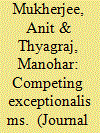

|
|
|
|
|
| Publication |
2012.
|
| Summary/Abstract |
This article analyses US-India strategic relations and the potential role of defence trade. First, it argues that cooperative relations between the two countries are hindered by "competing exceptionalisms" and the lack of a pre-existing model for the relationship. At the same time, bilateral relations are being strengthened by a convergence of interests and increasing societal linkages. Even on issues that have historically divided New Delhi and Washington-such as relations with third countries-there is a more nuanced understanding of differing perspectives in both capitals. Second, the article analyses the role of defence trade in the bilateral relationship. While describing recent trends, it also examines existing problems and peculiarities. The authors make two recommendations and argue that US-India relations, despite their differences, have fundamentally transformed and are set irrevocably on an upward trajectory.
|
|
|
|
|
|
|
|
|
|
|
|
|
|
|
|
| 2 |
ID:
114918


|
|
|
|
|
| Publication |
2012.
|
| Summary/Abstract |
Arvind Subramanian's recent book, Eclipse: Living in the Shadow of China's Economic Dominance, has renewed interest in measuring the potential of emerging powers. Subramanian argues that projections of gross domestic product (GDP), trade and creditor status make China's future dominance inevitable.
The focus, however, on a narrow metric like GDP growth rate to anticipate the dominant powers of tomorrow is flawed. For one, the GDP figure tells us little about the quality of a nation's economy or whether its wealth is being converted into competitive capabilities. For example, China's $5 trillion GDP, second-biggest globally, hides more than it reveals. Nearly half of China's GDP is driven by investment, mainly in real estate and infrastructure. It is unclear whether this build of fixed-asset investment is producing capabilities or knowledge that great powers typically possess. The other major driver of China's economy is its role as a manufacturing hub. What is less known is that foreign multinational corporations (MNCs) account for 60 per cent of China's trade and 80 per cent of the value of their exports is imported. In other words, the value addition that occurs in China itself is a tiny contribution in the overall production process. Even China's creditor status is circumscribed by the fact that China's reserve assets are denominated in currencies printed by its principal debtors who have, consequently, transferred the vulnerability of this imbalance onto China.
|
|
|
|
|
|
|
|
|
|
|
|
|
|
|
|
| 3 |
ID:
114917
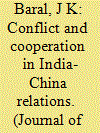

|
|
|
|
|
| Publication |
2012.
|
| Summary/Abstract |
India-China relations, though occasionally showing signs of peace and cooperation, have often been afflicted by tension and mistrust. With the potential to make big contributions to regional peace and development, these two Asian powers have, by design or accident, themselves been the sources of regional tension and insecurity to some extent. Besides their internal dynamics, the interplay of interests and moves of their neigbours, and several external powers would have significant bearing on the equation and relations between them.
|
|
|
|
|
|
|
|
|
|
|
|
|
|
|
|
| 4 |
ID:
114919
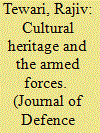

|
|
|
|
|
| Publication |
2012.
|
| Summary/Abstract |
Imagine if there is a war between India and Pakistan and the National Museum at New Delhi was vandalized and precious historical artifacts and other historical objects were stolen; or close your eyes and visualize India without the Taj Mahal which may be destroyed in an air attack. The standing bodhisattvas, dating back to seventh century AD, and the arms and armours of the Mughal era are some of the fabulous cultural wealth stored in the National Museum that is priceless for the nation and the loss of which can be the loss of the entire golden history of that era. That is literally what has happened to the Iraq National Museum in Baghadad (the Archaeological Institute of America has raised concern on the subject). Many artifacts contained in the museum were excavated from what has come to be known as the "Cradle of Civilisation" and artifacts-like a Sumerian marble head of a woman from Warka, dated 3000 BC and measuring 20 cm high-were found stolen from the National Museum in Baghdad. The fog of war and the instability that followed led to the looting and disappearance of thousands of such priceless artifacts from Baghdad National Museum and have sent alarm bells ringing regarding the preservation of cultural heritage in any armed conflict. The Chinese Cultural Revolution was another example of what harm can be done to the cultural heritage and how history can be obliterated and precious artifacts destroyed in the event of hostility breaking out.
|
|
|
|
|
|
|
|
|
|
|
|
|
|
|
|
| 5 |
ID:
114912


|
|
|
|
|
| Publication |
2012.
|
| Summary/Abstract |
While delivering the keynote address at the International Seminar on Defence Acquisitions on July 12, 2011, Defence Minister A.K. Antony accepted the need to impart training to the defence acquisition functionaries. Further, he agreed that a dedicated institute needs to be set up for the purpose. It is the first time that the training of acquisition staff has received the attention that it deserves as reforms in India's defence acquisition regime have so far been limited to procedures only. Overlooking the fact that any mechanism is as good as the people who operate it, professional competence of the personnel implementing the procedures was given little importance. The lack of a core of well-qualified and adequately-trained acquisition staff became the weakest link of the acquisition chain and this deficiency was first highlighted in an article that appeared in 2005 in Indian Defence Review.
|
|
|
|
|
|
|
|
|
|
|
|
|
|
|
|
| 6 |
ID:
114916
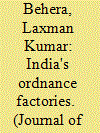

|
|
|
|
|
| Publication |
2012.
|
| Summary/Abstract |
The ordnance factory organization has grown over the years and now consists of 39 factories with two more being set up. The organization, which dates back to the eighteenth century, has however not been able to rise up to the expectation of its prime customer. The paper argues that for the organization to be able function more efficiently, its management needs to be corporatised, as suggested by many, particularly the Kelkar Committee. At the same time, the organization has to assume higher responsibility with respect to R&D investment, execution of contracts, quality assurance and exports, in order to remain competent in its area of functioning.
|
|
|
|
|
|
|
|
|
|
|
|
|
|
|
|
| 7 |
ID:
114914
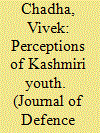

|
|
|
|
|
| Publication |
2012.
|
| Summary/Abstract |
The year 2011 was characterized by relative peace in the Kashmir Valley, especially when compared with the previous three years. A study undertaken on behalf of the Ministry of Home Affairs provides empirical indicators of the mood of the youth in six districts of the Valley. The study substantiates certain existing assessments based on environmental realities; however, it also raises other issues which come as a surprise to most. This article analyses five of these factors from a security perspective, based on the details that have emerged and other independent assessments. These are dovetailed to create a possible scenario which, along with the assessments, becomes the basis of policy recommendations. This is aimed at reinforcing previous successes and arresting disturbing trends in the state.
|
|
|
|
|
|
|
|
|
|
|
|
|
|
|
|
| 8 |
ID:
114915
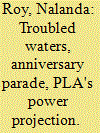

|
|
|
|
|
|
|
|